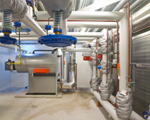Hospitals and Healthcare Facilities have requirements for large volumes of ventilation and strict control of airflow, and the greater the airflow, the greater the potential for noise. Building mechanical services equipment, fans, pumps, cooling, and heating equipment are all sources of high noise levels. When Acoustics By Design works on a new hospital, we typically expend half of our effort on attenuating building mechanical systems noise. In order to avoid the need for extensive noise and vibration isolating constructions, project designers and engineers should pay careful attention to mechanical room sizes and locations during schematic design. Here are some issues to address early on…
Designers should not locate extremely noise sensitive rooms, such as patient rooms, physician sleep rooms, and chapels adjacent to HVAC equipment rooms, and they should plan space in mechanical rooms and layout ductwork to allow for duct silencers. Even spaces that are only somewhat noise sensitive, such as exam rooms and operating rooms, should be located elsewhere. If noise sensitive spaces are located next to mechanical rooms, then heavier, thicker, and more expensive wall types will be needed.
The duct silencers should attenuate ductborne fan noise before the duct passes through mechanical room walls to adjacent spaces. Often, we are brought onto a project after the completion of schematic design and are told that there is insufficient space for duct silencers inside of the mechanical room and that the silencers must be located outside of the room. This means that the length of duct between the through-penetration of the mechanical room wall and the silencer will radiate noise into the adjacent space through which the duct travels. In this situation it may be necessary to wrap the duct with mass loaded lagging material, enclose it in gypsum board, construct horizontal shaftwalls, or take additional steps to mitigate the radiated noise.
Vertical adjacencies to the mechanical rooms can be of as much concern as these horizontal adjacencies. Depending on the levels of noise produced by the mechanical equipment to be installed, it may be necessary to increase the thickness of mechanical room floor slabs or to use floated floor slabs in order to avoid impacting noise sensitive spaces below the mechanical room.
In addition to noise, mechanical equipment located on upper floors will cause vibration of the floor slab. This vibration can be reduced by the proper selection of vibration isolation mounts. However, even with vibration isolation mounts, vibration levels can interfere with the use of vibration sensitive equipment. This is most commonly a concern for neurosurgery suites, which should not be located beneath mechanical rooms because they often contain vibration sensitive equipment that is suspended from the underside of the floor slab above.
Don’t wait for noise and vibration to become a problem in your new healthcare project. The new Facility Guideline Institute AIA/ASHE Guidelines for Design and Construction of Health Care Facilities provide specific recommendations for mechanical noise and vibration control. Get an acoustical consultant involved early in the design process, and many of the problems can be solved or avoided altogether. A good design will simplify the noise isolating constructions, reduce construction costs, and provide a quieter healing environment for patient rooms. That creates a win-win for the hospital and for the patients.
